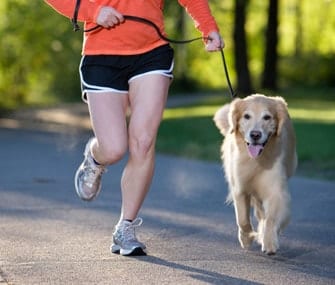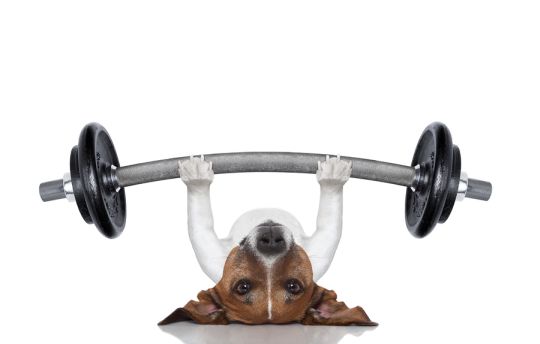Updated 18/01/2023
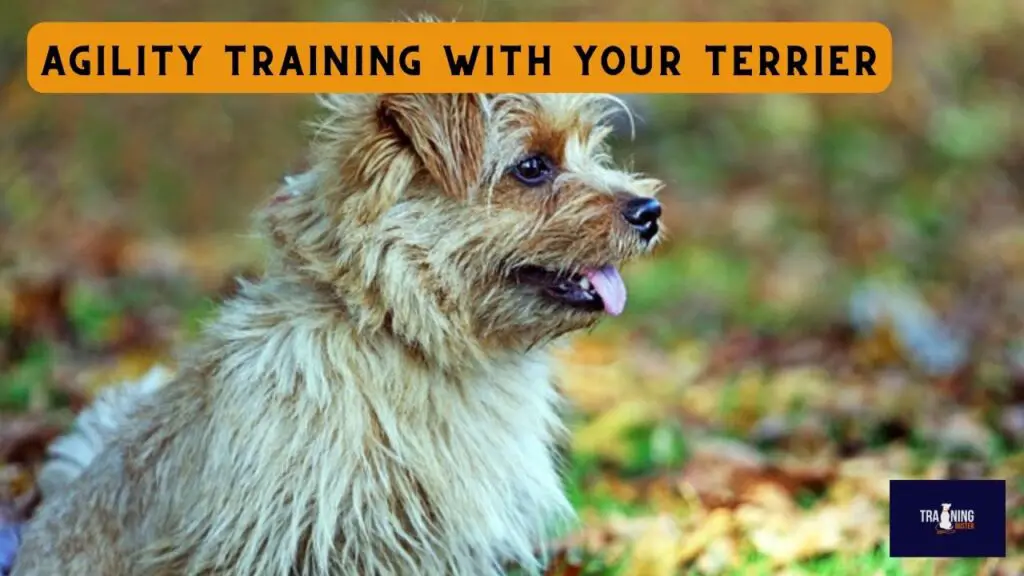
If you’re about to start taking your terrier to agility classes, congratulations! Agility is a sport that terriers enjoy, and tend to be good at.
What Is Agility Training for Dogs?
Agility training for dogs is a form of physical and mental exercise that focuses on teaching them to navigate an obstacle course.
It typically involves a sequence of obstacles like jumps, tunnels, weave poles, and ramps. The goal is for the dog to complete the course in the least amount of time with few mistakes. Agility training is a great way to bond with your pup and keep them fit and healthy.
Does Agility Training With Your Terrier improve Health?
Yes, agility training with your terrier can improve his health. By providing your terrier with physical exercise, you can help him maintain a healthy weight and build muscle, which can help improve his overall health.
Additionally, agility training can help to improve your terrier’s balance, coordination, and confidence. This can improve his overall mental and emotional health, and even help to reduce anxiety and stress.
Jumping with Your Terrier
Terriers usually love to jump. They typically do it at the wrong time, though – perhaps your terrier jumps up on you because they’re happy to see you when you come home, or when they hear their lead jingling.
Part of the reason terriers are suited to agility is that the ability to jump high is a skill they already have. But you don’t want them to jump up and take something out of your hand – this is dangerous.
Thankfully, doing agility with your terrier helps to boost their obedience, so that they reach a stage where they only jump on your command.
When practising at home, try placing a broom or mop on two stacks of books, and have your terrier jump over this. If they can do this with ease, feel free to add another book or two at either side. Don’t push it though – you don’t want to injure your pooch.
Agility Training – Weaving
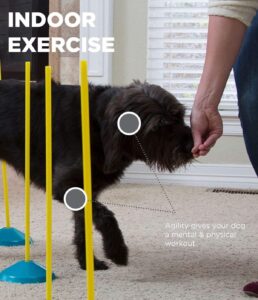
At agility classes, the slalom poles test your terrier’s obedience, flexibility, and bond with you. Weaving is also a really cool skill.
But you don’t need to wait until you go to class to practice this – your terrier can weave anywhere.
If you’re out walking and come across parking-bollards or a small fence, try holding a treat in front of your terrier’s nose and walking ahead, weaving the treat in and out of the poles.
If the bollards are short, this should work well with your dog still on the lead.
As well as this, you could teach your terrier to weave an 8 around your legs in a similar way. Just hold a treat in front of them and they will chase it as you wave it between your legs.
Helping to increase flexibility and spatial awareness, this is an impressive trick even by itself.
Both these methods of practice will boost your terrier’s flexibility and prepare them for agility. Again You can find a ZipZoom Beginner Dog Agility Training Obstacle Course for a great price on Amazon here
Agility Training – Balance
If your terrier starts going to agility classes, they’ll need great balance, stability, and trust, for walking on the see-saw. Practicing being on unsteady objects at home goes a long way in getting your terrier to tolerate using the see-saw in class.
Do you have a skateboard at home? Placing your terrier on the skateboard, supporting them, then slowly letting go of them on a flat, stationary surface can greatly help your terrier in getting used to unstable surfaces like this.
Or, if you have a wobble board, placing them on this in a similar way would be another good way to familiarize them with surfaces that wobble.
If you have neither of these things, a board or piece of wood with something small underneath it like a tennis ball or building block is also a great way to get your terrier used to the strange, unusual surface a see-saw will be for them. We have a post with our favorite back yard training gear here.
Agility Training – Heeling/Handling
Every moment is an opportunity for practice. When you’re out on your walks, work on your handling by training your terrier to heel. Hold a treat by your side when you’re walking together, to help get your terrier to walk calmly and slowly beside you.
You can then even show them which side you want them to walk on in this way. Don’t let them bite the treat out of your hand, though.
If you feel comfortable, you could even begin to jog with your terrier like this. But also, you should train your terrier to know that they don’t have to be directly beside you all the time.
Throw a treat away from you every now and then during walking sessions in an area you feel comfortable in, to help them understand this.
This is an important skill to develop for agility, and it’s something terriers can struggle with.
What equipment do I need for agility training with my terrier?
When it comes to agility training equipment, there are a few key pieces you’ll need to get started. Here are some of the most important items:
Agility jumps: These are typically lightweight and adjustable, and they come in different shapes and sizes.
You can start with a simple hurdle-style jump and gradually increase the height and difficulty as your dog improves.
Agility tunnels: These are flexible tubes that your dog can run through, and they come in different lengths and shapes. Tunnels are great for building speed and agility, and they’re also a lot of fun for your dog.
Weave poles: These are a series of poles that your dog weaves in and out of, and they’re great for building agility and coordination. You can start with just a few poles and gradually increase the number as your dog improves.
Contact obstacles: These include things like a dog walk, A-frame, and a teeter-totter. Contact obstacles are more challenging and require your dog to make contact with specific areas of the obstacle while navigating it.
Agility cones/markers: These are used to mark the course and can be helpful for training and practising. You can use cones or markers to set up a course and practice different sequences.
In addition to these pieces of equipment, you’ll also need a leash, collar, and treats for training. It’s important to start with basic training and build up to more difficult obstacles as your dog improves.
Have fun with training
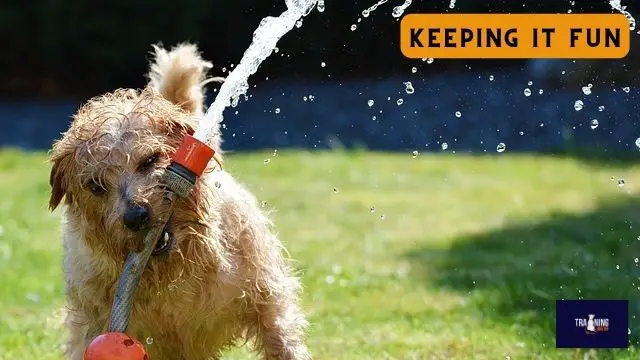
The most important aspect of agility is keeping it fun. This way, your terrier wants to keep doing it. When you’re first beginning your home training, keep the sessions very short.
10 minutes or so. This will keep your dog interested for the long term – there’s no rush for your dog to learn each skill, after all, because unlike obedience skills like sitting, staying and coming when called, these skills are mainly just for showing off and improving your terrier’s physical health.
Keep up your existing tricks with your Terrier
When you’re both waiting for your next class, it’s a good idea to keep practising your existing tricks that are unrelated to agility.
Mastering your terrier’s “Sit”, for example, will go a long way in helping them to wait their turn off the lead while the other dogs at your agility class have their turn on the course.
Or, working on their ability to return to you when called means that you can both stay on course while waiting and while actually carrying out the course.
Your terrier is more likely to carry out the course properly if you can get them to stick beside you when needed, too.
And if you have a lot of fun with your terrier and they trust you, your terrier is much less likely to jump off when you both make it to the point of using the agility see-saw.
How long does it take to train a terrier for agility?
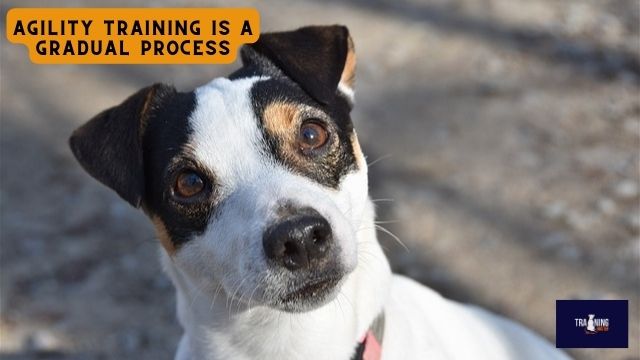
One important thing to keep in mind is that agility training is a gradual process that requires patience and consistency.
You’ll need to start with basic training exercises and gradually build up to more advanced obstacles and sequences. This can take time, especially if your terrier is new to agility training.
Another important factor to consider is your own commitment to the training process. You’ll need to set aside time for regular training sessions, and you’ll need to be consistent with your training techniques and positive reinforcement.
If you’re consistent and committed, you’ll be more likely to see results in a reasonable amount of time.
It’s also important to remember that every dog is different, and some terriers may take longer to learn and master agility training than others.
But with patience, consistency, and lots of positive reinforcement, you can help your terrier reach their full potential and become a skilled agility dog.
In summary, while there is no one-size-fits-all answer to how long it takes to train a terrier for agility, you can expect the process to take several months to a year or more.
With patience, consistency, and commitment, you can help your furry friend become a skilled and confident agility dog.
How long does it take to train a terrier for agility?
One important thing to keep in mind is that agility training is a gradual process that requires patience and consistency.
You’ll need to start with basic training exercises and gradually build up to more advanced obstacles and sequences. This can take time, especially if your terrier is new to agility training.
Another important factor to consider is your own commitment to the training process. You’ll need to set aside time for regular training sessions, and you’ll need to be consistent with your training techniques and positive reinforcement.
If you’re consistent and committed, you’ll be more likely to see results in a reasonable amount of time.
It’s also important to remember that every dog is different, and some terriers may take longer to learn and master agility training than others.
But with patience, consistency, and lots of positive reinforcement, you can help your terrier reach their full potential and become a skilled agility dog.
In summary, while there is no one-size-fits-all answer to how long it takes to train a terrier for agility, you can expect the process to take several months to a year or more.
With patience, consistency, and commitment, you can help your furry friend become a skilled and confident agility dog.
Can I do agility training with my terrier indoors?
The good news is that agility training can definitely be done indoors, especially if you have limited outdoor space or live in an area with inclement weather.
In fact, there are many indoor agility training facilities that cater to dog owners who want to train their dogs in a safe and controlled environment.
When it comes to indoor agility training, you can use a variety of equipment to help your terrier build their agility and coordination skills
Targeting equipment: These include things like cones or markers, which can be used to mark a course or specific spots for your terrier to target.
When doing indoor agility training, it’s important to make sure that the space is safe and free from any hazards that could cause injury to your terrier.
You should also start with basic exercises and gradually increase the difficulty and complexity of the training.
What are some common mistakes to avoid when doing agility training with my terrier?
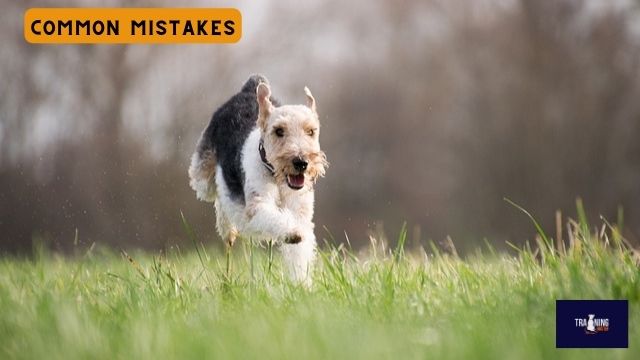
Here are some common mistakes to avoid when doing agility training with your terrier:
Skipping basic training: It’s important to start with basic obedience training before moving on to agility training. Skipping this step can lead to confusion and frustration for your terrier, as well as unsafe training practices.
Overworking your terrier: Agility training is a physically demanding activity, and it’s important to avoid overworking your terrier. Be sure to give your furry friend plenty of breaks and rest, and never push them beyond their physical limitations.
Ignoring safety measures: Agility training involves a lot of jumping, weaving, and running, and it’s important to take safety precautions to prevent injury to your terrier. Make sure your equipment is set up properly, and never force your terrier to attempt an obstacle they are uncomfortable with.
Using harsh training methods: Positive reinforcement is key to successful agility training. Using harsh or punitive training methods can undermine your terrier’s confidence and make the training process less enjoyable for both of you.
Not being consistent: Consistency is key when it comes to agility training. If you’re inconsistent with your training methods or don’t set aside enough time for regular training sessions, you may not see the progress you’re hoping for.
By avoiding these common mistakes, you can ensure a safe and effective training experience for you and your terrier. With patience, consistency, and positive reinforcement, you can help your furry friend become a skilled and confident agility dog.

